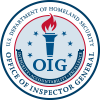The United States Coast Guard (Coast Guard) was not able to consistently interdict non-commercial vessels smuggling drugs into the United States. From fiscal years 2021 through 2023, the Coast Guard interdicted an estimated 421.9 metric tons of cocaine but fell short of its total cocaine removal goal of 690 metric tons. This occurred, in part, because the Coast Guard did not always have cutters available to perform the counterdrug mission and did not have a contingency plan to address the cutters’ unavailability. We found Coast Guard cutters were unavailable for 2,058 cumulative days over a 3-year period. Using the Coast Guard’s formula, we calculated that the Coast Guard could have interdicted an additional 57 to 89.1 metric tons of cocaine had these cutters been performing the counterdrug mission.
Title Full
The Coast Guard Faces Challenges Interdicting Non-Commercial Vessels Smuggling Drugs into the United States
Date Issued
Submitting OIG
Department of Homeland Security OIG
Agencies Reviewed/Investigated
Department of Homeland Security
Report Number
OIG-25-17
Report Description
Report Type
Audit
Agency Wide
Yes
Number of Recommendations
4
Questioned Costs
$0
Funds for Better Use
$0
Report updated under NDAA 5274
No
External Entity
USCG
Open Recommendations
This report has 1 open recommendations.
| Recommendation Number | Significant Recommendation | Recommended Questioned Costs | Recommended Funds for Better Use | Additional Details | |
|---|---|---|---|---|---|
| 1 | No | $0 | $0 | ||
| We recommend the Commandant of the Coast Guard develop and implement a drug interdiction contingency plan to prioritize the availability of cutters for drug interdiction missions and to mitigate the risk of cutters being unavailable. | |||||


